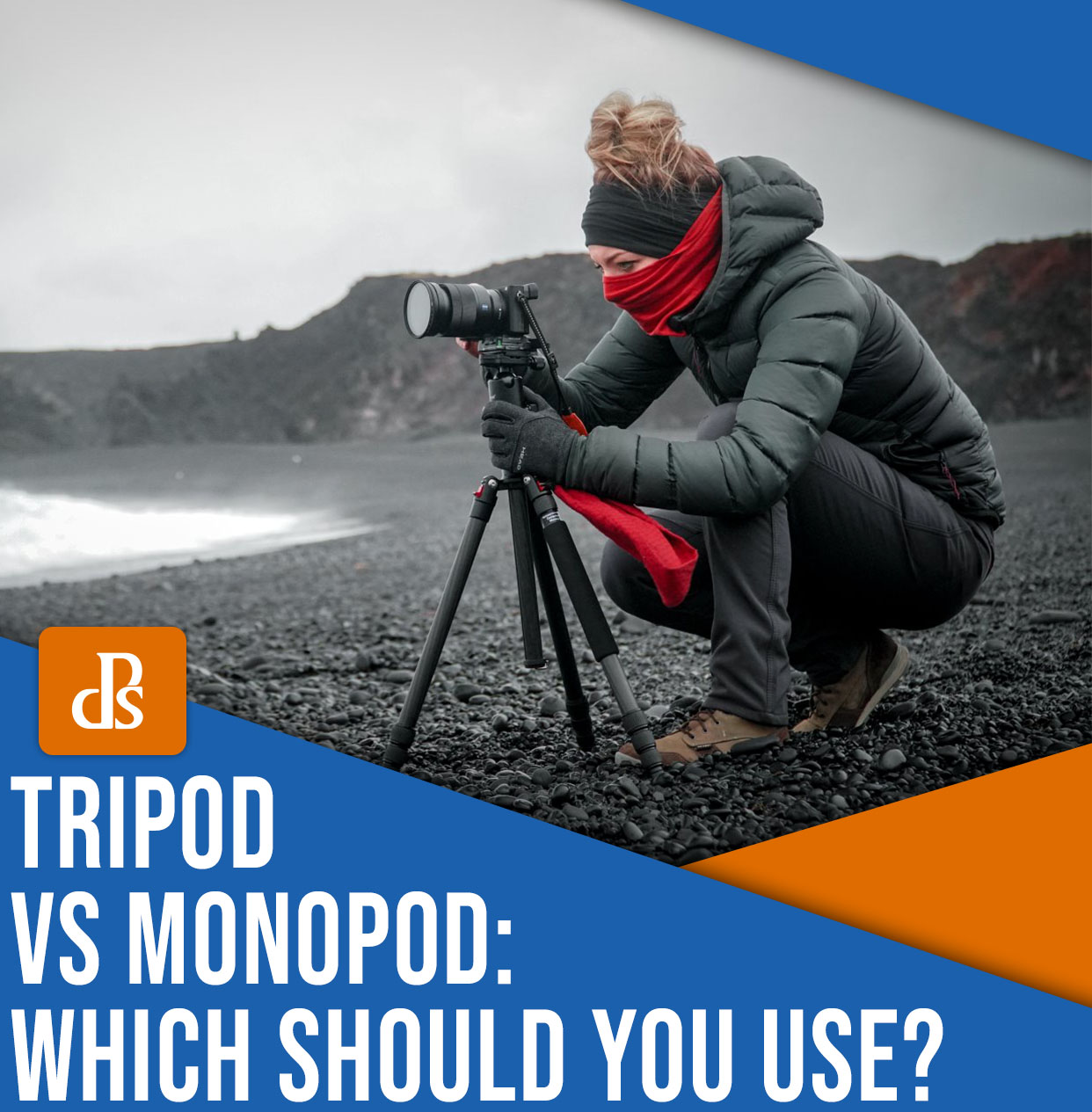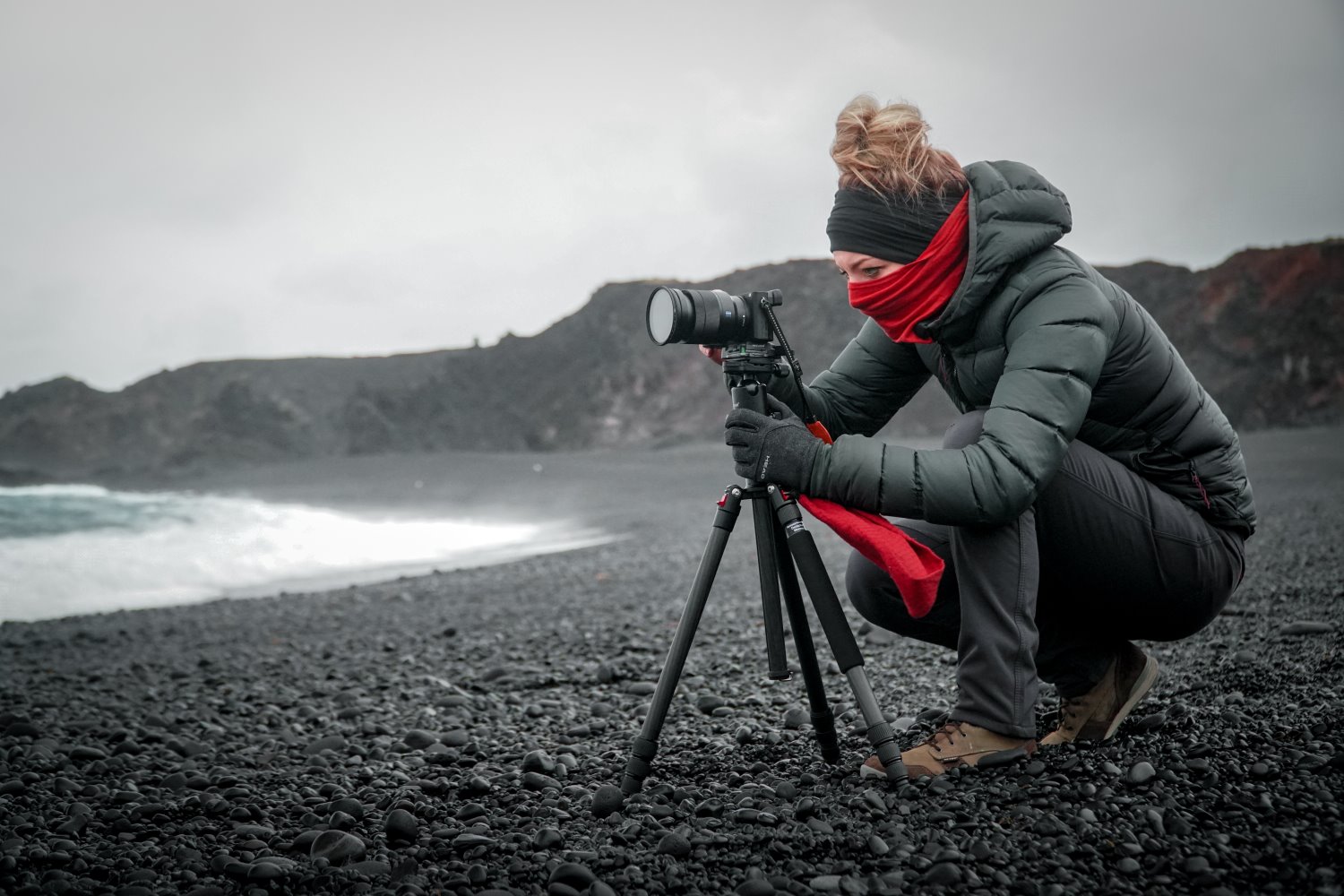
Tripods and monopods are popular camera accessories designed to keep your camera and lens stable. But while both products have their benefits, they’re not identical – and they also come with several major (but different) drawbacks.
In this article, I share everything you need to know about tripods vs monopods. I discuss their advantages, their disadvantages, and I explain which one is the better choice for your needs.
Let’s dive right in!
What is a tripod?
Pretty much every photographer, from beginner to professional, has seen a tripod; it’s a three-legged accessory that supports camera rigs.

With your camera mounted to a tripod, you’re free to walk around, investigate different compositions, even leave the scene and come back – though as I explain below, the primary benefit of a tripod is its stability, which allows you to eliminate camera shake and create stunning long-exposure images.
Note that tripods vary widely in terms of maximum and minimum height, sturdiness, and weight. You can grab lightweight tabletop tripods that can literally fit in a purse, and you can also purchase huge carbon fiber tripods that are cumbersome to carry but are rock-solid in the field.
What is a monopod?
A monopod, as the name suggests, is like a tripod, except it has only one leg:

You might think of a monopod as a walking stick for your camera. It’ll support a camera rig, it’ll improve stability, but it won’t stand on its own. As you can probably imagine, this comes with various drawbacks – discussed in detail below – but also several major advantages, including greater speed and flexibility.
Like tripods, different monopods offer different levels of sturdiness, heights, and weights.
Tripod vs monopod: tripod benefits
Many professional photographers prefer tripods over monopods, for two key reasons:
1. Tripods are far more stable

While a monopod can reduce camera shake – leading to sharper photos, especially in low-light scenarios – a sturdy tripod can eliminate camera shake completely.
With a tripod, you can capture long-exposure landscape photos that feature a mix of tack-sharp detail and motion blur (due to moving water and clouds). That’s why tripods are heavily favored by landscape photographers and astrophotographers; without a tripod, their long-exposure shots would be soft throughout, and though a monopod might somewhat reduce this softness, it just isn’t stable enough to get pro-level results.
Tripods are also favored by product and still-life photographers. Often, these photographers need to focus stack (i.e., capture several identical images with different focus points), and a sturdy tripod is essential for maintaining the camera position as they fire off multiple shots.
2. Tripods force you to slow down

Most photographers don’t really think about this, but tripods are slow to set up. And while this can be a drawback (see below!) it can also be a benefit.
The extra effort that goes into tripod setup forces you to really think about each composition and whether it’s genuinely worth pursuing. And as you set up the tripod, you may notice other composition opportunities that you wouldn’t have considered had you been working with a (much faster) monopod.
Tripod vs monopod: tripod drawbacks
Tripods are invaluable photographic accessories, yet they come with plenty of difficulties. Here are a few key downsides to consider:
1. Tripods are expensive

There are a lot of cheap tripods on the market. Unfortunately, these products tend to be very low quality, which means that they’re often very difficult to use and they won’t keep your camera steady in most (if not all) cases.
Good, sturdy tripods that are capable of capturing long-exposure images often cost a pretty penny. Many photographers purchase tripod legs and the tripod head separately; depending on your desired stability, portability, and features, expect to pay $500+ for a satisfactory model.
2. Tripods are cumbersome and inconvenient
Nearly every tripod ever made – regardless of the price – has been far more cumbersome than a standard monopod. (The exception is tabletop tripods, though these are limited in their functionality.)
Tripods are heavier than monopods, which means that you may start to feel fatigued or even frustrated carrying one around all day. They’re also more difficult to pack in a camera bag or a suitcase, and when fully extended, they can get in the way (which is why tripods can often cause problems when used along busy city sidewalks, for instance, and why tripods are often banned from museums and other popular attractions).
3. Tripods are slow
I know, I know; in the previous section, I claimed that the slow, deliberate tripod approach was beneficial! And that’s true – it can be helpful – but in certain situations, it can also be a drawback.
For instance, if you’re photographing from the bleachers at a football game, every time you change position, you’ll need to fold up your tripod legs. Then, once you’ve found your new spot, you’ll need to get set up again, during which you may miss out on some key images.
In other words, when you’re working in a fast-paced scenario, a monopod is likely the better accessory to have; it’ll keep your camera sturdy, but it won’t take precious seconds to set up and take down and set up again.
Tripod vs monopod: monopod benefits
Tripods might be the more popular option, but monopods certainly have their place. Here’s why:
1. Monopods are faster and more flexible

Sports photographers love to use monopods. You can set up a monopod in seconds, and once your camera is mounted to the monopod head, you’ll never have to take it off.
Action is happening at the far end of the field? No problem! Just grab your entire rig and sprint into position. Because monopods are so much slimmer than tripods, you won’t have to worry about hitting pedestrians or other photographers along the way.
And because monopods are so much lighter than tripods, they’re easy to carry around without getting tired. In fact, a monopod will prevent fatigue by supporting your heavy lenses.
2. Good monopods cost less

As I explained above, tripods can be very pricey, especially if you’re looking for a model that can handle difficult outdoor scenarios.
But a solid monopod costs nowhere near as much. You can grab a very nice monopod for around $100 – one that you can use in plenty of situations – though you’ll generally need to buy a head separately, so do bear that in mind before purchasing.
Tripod vs monopod: monopod drawbacks
Monopods come with one major disadvantage:
1. A monopod won’t keep your camera rock-steady
Monopods are great, and they certainly allow you to shoot for long hours without arm fatigue and lower your shutter speed while capturing sharp photos.
But a monopod, no matter the quality, won’t keep your camera completely steady. You can’t use a monopod to capture a 10-second long-exposure shot, which is the reason landscape photographers (and other long-exposure fine-art photographers) almost never use them.
Tripod vs monopod: which should you choose?

Tripods and monopods both offer lots of support for your camera, and they both have their place in a photographer’s toolkit. However, there are a handful of scenarios where a monopod is better than a tripod or vice versa.
Specifically, I recommend purchasing a monopod if:
- You often shoot in fast-paced scenarios where speed is key
- You work with long lenses and want to give your arms a break
- You need a bit of extra stability but aren’t looking to capture long-exposure shots
- You work in low-light scenarios and want to be able to marginally lower your shutter speed without issue
On the other hand, I’d encourage you to buy a tripod if:
- You want to capture long-exposure images of landscapes, cityscapes, or the night sky
- You don’t mind working at a slower pace
- You’re willing to spend significant money for a quality product
- You need to capture multiple images with identical framing
Tripod vs monopod: final words
Now that you’ve finished this article, you know the benefits and drawbacks of tripods and monopods – and you’re hopefully ready to make a purchase.
Remember that tripods and monopods are both excellent pieces of equipment. The key is to figure out what you want to shoot, then make your purchase accordingly.
Now over to you:
Which do you plan to use, a tripod or a monopod? Have you tried either option before? Share your thoughts in the comments below!


